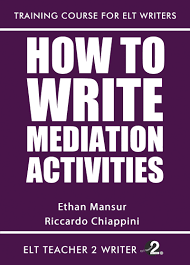10+1 Reasons Why you Should Read How to Write Mediation Activities

I first came across Ethan Mansur and Riccardo Chiappini’s work on mediation at Innovate ELT 5 years ago. I was fascinated by the topic, the activity types and the way in which they engaged us in a highly participant-centred session.
Since then, not only have I read more of their work, such as books and free-access articles and books but I have also attended their IATEFL talks and been inspired to talk about mediation in some of my teacher training sessions.
Some reasons to get the book
This article is about their new book How to write Mediation activities and 10+1 reasons why you should add it to your shelf.
- What is mediation? How can I design mediation activities? How would my students benefit from mediation practice?
If you are asking yourself these questions, Ethan and Riccardo’s new book will provide the answers . They break down the three types of mediation, such as mediating a text, mediating concepts and mediating communication. They explain what mediation activities are, why they matter, and how to create them.
2) This book is not all theory. It lists practical strategies as well as lesson ideas that you can use tomorrow. Whether you are a Business or a General English teacher, you will definitely find some material for your classes.
3) The book will help you understand if you are already using mediation activities. And I’m sure you are. For instance, when you’re asking your students to summarise a text to a friend, you are asking them to mediate a text. One thing I learned from Riccardo and Ethan is that when I’m using the jigsaw technique, (which is very often!)I am asking my students to mediate a text. They need to process a video or a text in order to explain and/or present this information to someone else, in their own words.
4) The book follows a reflect and compare approach. This means the authors will scaffold your understanding and learning. They will guide you by inviting you to think of your own activities first. Next, they provide some suggested activities for you to check and compare. If you want to skip this step, it’s fine though. They refer you to a section where you can read the answer key.
5) It will help you write rubrics for your mediation activities.
There are some sample rubrics and some dos and dont’s in terms of elements that need to be included or not.
6) Another point that makes the book especially practical is that it includes loads of examples of useful language students can use in mediation tasks, such as how to explain something clearly, ask for clarification, or summarise key ideas. This feature can be particularly helpful for novice teachers who may not yet feel confident providing that kind of support on their own.’ See example below:
Language for summarising
To sum things up… Some of the most important points that have come up are… To highlight some of the main points
7) This book is less than 100 pages, written in very simple, accessible language. So don’t get discouraged thinking it is highly theoretical! You could easily read it in a day or two. My advice though is to read it slowly, experiment with some of the ideas and reflect on your key takeaways.
8) It includes a glossary with all the key terms, which means you won’t get confused at any point. This is very helpful, as it takes time to grasp key concepts.
9) The authors have presented and written a lot about mediation, so they are very knowledgeable. In fact, they have also written another great book, Activities for Mediation. Building bridges in the ELT classroom, which is a brilliant resource with about 40 lesson ideas.
10) Your students will thank you!
I used many of the suggested activities when teaching group classes. For instance, my teenagers truly enjoyed working in groups and taking turns to be the assessor in exam speaking tasks. They saw the value of these activities and realized how much they improved their communication skills.
Bonus reason
If you are an AI enthusiast who usually asks a chatbot to generate tasks and texts for your class, the writers will draw your attention to some key issues. A very useful section!
To sum up, a great resource for those wanting to learn to design mediation activities. Get a copy today and enable your students to break down communication barriers!
Coming soon! Please check the Pilgrims in Segovia Teacher Training courses 2026 at Pilgrims website
10+1 Reasons Why you Should Read How to Write Mediation Activities
Rachel Tsateri, GreeceProfessors at Play
reviewed by Hall Houston, TaiwanHalloween Reading Club from OUP
Women in ELT from Pavilion
DELTA News